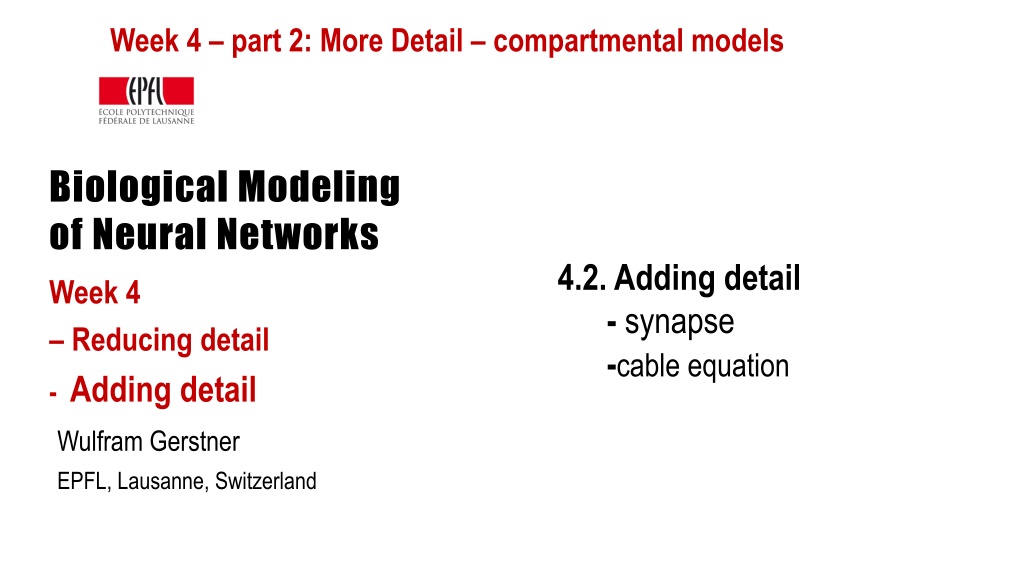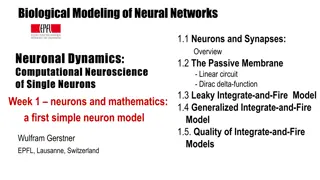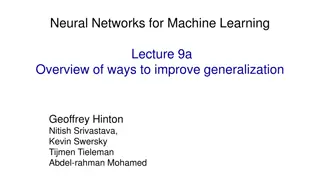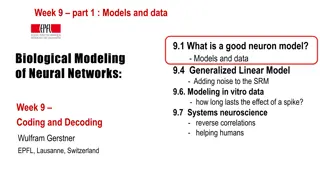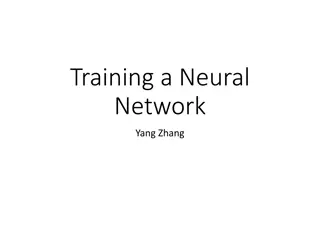Exploring Compartmental Models and Adding Detail in Neural Network Biological Modeling
Week 4 delves into compartmental models and the addition of synaptic and cable equation details in biological modeling of neural networks. The content is presented by Wulfram Gerstner from EPFL, Lausanne, Switzerland, providing insights into reducing and adding complexity for a comprehensive understanding of neural network functioning.
Download Presentation

Please find below an Image/Link to download the presentation.
The content on the website is provided AS IS for your information and personal use only. It may not be sold, licensed, or shared on other websites without obtaining consent from the author. Download presentation by click this link. If you encounter any issues during the download, it is possible that the publisher has removed the file from their server.
E N D
Presentation Transcript
Week 4 part 2: More Detail compartmental models Biological Modeling of Neural Networks Week 4 Reducing detail - Adding detail 4.2. Adding detail - synapse -cable equation Wulfram Gerstner EPFL, Lausanne, Switzerland
Neuronal Dynamics 4.2. Neurons and Synapses motor cortex frontal cortex to motor output
Neuronal Dynamics 4.2 Neurons and Synapses What happens in a dendrite? What happens at a synapse? action potential synapse Ramon y Cajal
Neuronal Dynamics 4.2. Synapses Synapse
Neuronal Dynamics 4.2 Synapses glutamate: Important neurotransmitter at excitatory synapses image: Neuronal Dynamics, Cambridge Univ. Press
Neuronal Dynamics 4.2. Synapses glutamate: Important neurotransmitter at excitatory synapses -AMPA channel: rapid, calcium cannot pass if open -NMDA channel: slow, calcium can pass, if open (N-methyl-D-aspartate) GABA: Important neurotransmitter at inhibitory synapses (gamma-aminobutyric acid) Channel subtypes GABA-A and GABA-B
Neuronal Dynamics 4.2. Synapse types Model? ( ) ( syn syn g t g e = ( )/ t t ) t t k k = syn ( ) t ( )( t u ) I g E syn syn image: Neuronal Dynamics, Cambridge Univ. Press
Neuronal Dynamics 4.2. Synapse model Model? = ( )/ t t ( ) t ( ) g g e t t k syn syn k = syn ( ) t ( )( t u ) I g E syn syn image: Neuronal Dynamics, Cambridge Univ. Press
Neuronal Dynamics 4.2. Synapse model Model with rise time ( )/ ( ( ) [1 syn syn k = ] ( )/ t t t t ) g t g e e t t k k rise k = syn ( ) t ( )( t u ) I g E syn syn du dt image: Neuronal Dynamics, Cambridge Univ. Press = + 3 4 stim ( ) ( ) ( ) ( ) t C g m h u E g n u E g u E I Na Na K K l l
Neuronal Dynamics 4.2. Synaptic reversal potential glutamate: excitatory synapses = syn ( ) t ( )( t u ) I g E syn syn 0 E mV syn GABA: inhibitory synapses ( ) I t = syn ( )( t u ) g E syn syn 75 E mV syn
Neuronal Dynamics 4.2. Synapses = stim syn ( ) t ( ) t I I glutamate: excitatory synapses = syn ( ) t ( )( t u ) I g E syn syn 0 E mV syn GABA: inhibitory synapses ( ) I t = syn ( )( t u ) g E syn syn 75 E mV syn
Neuronal Dynamics 4.2.Synapses Synapse
Neuronal Dynamics Quiz 4.3 Multiple answers possible! AMPA channel [ ] AMPA channels are activated by AMPA [ ] If an AMPA channel is open, AMPA can pass through the channel [ ] If an AMPA channel is open, glutamate can pass through the channel [ ] If an AMPA channel is open, potassium can pass through the channel [ ] The AMPA channel is a transmitter-gated ion channel [ ] AMPA channels are often found in a synapse Synapse types [ ] In the subthreshold regime, excitatory synapses always depolarize the membrane, i.e., shift the membrane potential to more positive values [ ] In the subthreshold regime, inhibitory synapses always hyperpolarize the membranel, i.e., shift the membrane potential more negative values [ ] Excitatory synapses in cortex often contain AMPA receptors [ ] Excitatory synapses in cortex often contain NMDA receptors
Week 4 part 2: More Detail compartmental models 3.1 From Hodgkin-Huxley to 2D 3.2 Phase Plane Analysis 3.3 Analysis of a 2D Neuron Model 4.1 Type I and II Neuron Models - limit cycles - where is the firing threshold? - separation of time scales 4.2. Dendrites - synapses -cable equation Biological Modeling of Neural Networks Week 4 Reducing detail - Adding detail Wulfram Gerstner EPFL, Lausanne, Switzerland
Neuronal Dynamics Review: Biophysics of neurons Cell surrounded by membrane Membrane contains - ion channels - ion pumps Dendrite and axon: Cable-like extensions Tree-like structure -70mV soma Na+ action potential K+ Ca2+ Ions/proteins
Neuronal Dynamics Modeling the Dendrite soma Dendrite Longitudinal Resistance RL I I gion C C gl gl
Neuronal Dynamics Modeling the Dendrite soma Dendrite Longitudinal Resistance RL I I gion C C Calculation
Neuronal Dynamics Conservation of current soma Dendrite RL I I gion C C
Neuronal Dynamics 4.2 Equation-Coupled compartments ) 2 ( , ) u t x + + ( , ( , ) u t x dx u t x dx d dt = + ext ( , ) u t x ( , ) t x ( , ) t x C I I ion R ion L Basis for -Cable equation I I gion C C -Compartmental models
Neuronal Dynamics 4.2 Derivation of Cable Equation ) 2 ( , ) u t x + + ( , ( , ) u t x dx u t x dx R L d dt = + ext ( , ) u t x ( , ) t x ( , ) t x C I I ion ion I I gion C C mathemetical derivation, now 2 d dx d dt = + ext 2( , ) u t x ( , ) u t x ( , ) t x ( , ) t x cr r ion i r i L L L ion
Neuronal Dynamics 4.2 Modeling the Dendrite = = R C r dx cdx L L gion g = = I ion i dx i ion ext ext I dx
Neuronal Dynamics 4.2 Derivation of cable equation ) 2 ( , ) u t x + + ( , ( , ) u t x dx u t x dx d dt = + ext ( , ) u t x ( , ) t x ( , ) t x C I I ion R ion L = = R C r dx cdx L L = = I ion i dx i ion ext ext I dx 2 d dx d dt = + ext 2( , ) u t x ( , ) u t x ( , ) t x ( , ) t x cr r ion i r i L L L ion
Neuronal Dynamics 4.2 Dendrite as a cable 2 d dx d dt = + ext 2( , ) u t x ( , ) u t x ( , ) t x ( , ) t x cr r ion i r i L L L ion passive dendrite = ( , ) t x ion i leak ion active dendrite = ( , ) t x , ,... ion i Ca Na ion = axon ( , ) t x , ,... ion i Na K ion
Neuronal Dynamics Quiz 4.4 Multiple answers possible! Scaling of parameters. Suppose the ionic currents through the membrane are well approximated by a simple leak current. For a dendritic segment of size dx, the leak current is through the membrane characterized by a membrane resistance R. If we change the size of the segment From dx to 2dx [ ] the resistance R needs to be changed from R to 2R. [ ] the resistance R needs to be changed from R to R/2. [ ] R does not change. [ ] the membrane conductance increases by a factor of 2.
Neuronal Dynamics 4.2. Cable equation soma Dendrite RL I I gion C C
Neuronal Dynamics 4.2 Cable equation 2 d dx d dt = + ext 2( , ) u t x ( , ) u t x ( , ) t x ( , ) t x cr r ion i r i L L L ion passive dendrite = ( , ) t x ion i leak ion active dendrite = ( , ) t x , ,... ion i Ca Na ion = axon ( , ) t x , ,... ion i Na K ion
Neuronal Dynamics 4.2 Cable equation Mathematical derivation 2 d dx d dt = + ext 2( , ) u t x ( , ) u t x ( , ) t x ( , ) t x cr r ion i r i L L L ion passive dendrite = ( , ) t x ion i leak ion active dendrite = ( , ) t x , ,... ion i Ca Na ion = axon ( , ) t x , ,... ion i Na K ion
Neuronal Dynamics 4.2 Derivation for passive cable 2 2( , ) ( , ) ( , ) L L ion L ion dx dt d d = + ext ( , ) t x u t x cr u t x r i t x r i passive dendrite = ( , ) t x ion i leak ion = = I ion i dx i ion ext ext I dx See exercise 3 u r = ( , ) t x ion i 2 d dx d dt = u r i + 2 ext 2( , ) u t x ( , ) u t x ( , ) t x ion m m m
Neuronal Dynamics 4.2 dendriticstimulation passive dendrite/passive cable soma 2 d dx d dt = u r i + 2 ext 2( , ) u t x ( , ) u t x ( , ) t x m m Stimulate dendrite, measure at soma
Neuronal Dynamics 4.2 dendriticstimulation soma The END
Neuronal Dynamics Quiz 4.5 Multiple answers possible! Dendritic current injection. If a short current pulse is injected into the dendrite [ ] the voltage at the injection site is maximal immediately after the end of the injection [ ] the voltage at the dendritic injection site is maximal a few milliseconds after the end of the injection [ ] the voltage at the soma is maximal immediately after the end of the injection. [ ] the voltage at the soma is maximal a few milliseconds after the end of the injection The space constant of a passive cable is [ ] m r r r r = L = L [ ] m r r = L [ ] m It follows from the cable equation that [ ] the shape of an EPSP depends on the dendritic location of the synapse. [ ] the shape of an EPSP depends only on the synaptic time constant, but not on dendritic location. r r = m [ ] L
Neuronal Dynamics Homework Consider (*) ( , ) 4 t ( , ) 0 u t x for t = x x 2 ( ) 1 = exp[ ] 0 0 u t x t for t 4 t 0 (i) Take the second derivative of (*) with respect to x. The result is 2 2( , ) .......... u t x dx d = (ii) Take the derivative of (*) with respect to t. The result is du t x dt = ( , ) .... (iii) Therefore the equation is a solution to 2 2 2( , ) m u t x dx dt .... m and = = d d = u r i + ext ( , ) u t x ( , ) t x m with ... = ( ) ( t i = for t x x ext (iv) The input current is [ ] ( , ) t x ( , ) t x ) i 0 0 ext [ ] i 0
Neuronal Dynamics Homework Consider the two equations 2 d dx d dt (1) = u r i + 2 ext 2( , ) u t x ( , ) u t x ( , ) t x m m 2 d dx d = u i + ext (2) 2( ', ) u t x ( ', ) u t x ( ', ) t x ' dt The two equations are equivalent under the transform ' x cx and t at = = with constants c= .. and a = ..
Neuronal Dynamics 4.3. Compartmental models soma dendrite RL I I gion C C
Neuronal Dynamics 4.3. Compartmental models + + ( , 0.5( 1) ( , ) ) L R ( , ) 0.5( ( , + 1) ) u t u t u t u t d dt = + ( , ) t ( , ) u t ( ) t C I I ion + 1 1 R R R ion L L L Software tools: - NEURON (Carnevale&Hines, 2006) - GENESIS (Bower&Beeman, 1995)
Neuronal Dynamics 4.3. Model of Hay et al. (2011) Morphological reconstruction -Branching points -200 compartments -spatial distribution of ion currents ( 20 ) m layer 5 pyramidal cell hotspot Ca currents Sodium current (2 types) - - Calcium current (2 types and calcium pump) Potassium currents (3 types, includes ) Unspecific current I HH-type (inactivating) persistent (non-inactivating) , Na transient I NaP I M
Neuronal Dynamics 4.3. Active dendrites: Model Hay et al. 2011, PLOS Comput. Biol.
Neuronal Dynamics 4.3. Active dendrites: Model Hay et al. 2011, PLOS Comput. Biol.
Neuronal Dynamics 4.3. Active dendrites: Experiments BPAP: backpropagating action potential Dendritic Ca spike: activation of Ca channels Ping-Pong: BPAP and Ca spike Larkum, Zhu, Sakman Nature 1999
Neuronal Dynamics 4.3. Compartmental models Dendrites are more than passive filters. -Hotspots -BPAPs -Ca spikes Compartmental models - can include many ion channels - spatially distributed - morphologically reconstructed BUT - spatial distribution of ion channels difficult to tune
Neuronal Dynamics Quiz 4.5 BPAP [ ] is an acronym for BackPropagatingActionPotential [ ] exists in a passive dendrite [ ] travels from the dendritic hotspot to the soma [ ] travels from the soma along the dendrite [ ] has the same duration as the somatic action potential Multiple answers possible! Dendritic Calcium spikes [ ] can be induced by weak dendritic stimulation [ ] can be induced by strong dendritic stimulation [ ] can be induced by weak dendritic stimulation combined with a BPAP [ ] can only be induced be strong dendritic stimulation combined with a BPAP [ ] travels from the dendritic hotspot to the soma [ ] travels from the soma along the dendrite
Neuronal Dynamics week4 Reading Reading: W. Gerstner, W.M. Kistler, R. Naud and L. Paninski, Neuronal Dynamics: from single neurons to networks and models of cognition. Chapter 3: Dendrites and Synapses, Cambridge Univ. Press, 2014 OR W. Gerstner and W. M. Kistler, Spiking Neuron Models, Chapter 2, Cambridge, 2002 OR P. Dayan and L. Abbott, Theoretical Neuroscience, Chapter 6, MIT Press 2001 References: M. Larkum, J.J. Zhu, B. Sakmann (1999), A new cellular mechanism for coupling inputs arriving at different cortical layers, Nature, 398:338-341 E. Hay et al. (2011) Models of Neocortical Layer 5b Pyramidal Cells Capturing a Wide Range of Dendritic and Perisomatic Active Properties, PLOS Comput. Biol. 7:7 Carnevale, N. and Hines, M. (2006). The Neuron Book. Cambridge University Press. Bower, J. M. and Beeman, D. (1995). The book of Genesis. Springer, New York. Rall, W. (1989). Cable theory for dendritic neurons. In Koch, C. and Segev, I., editors, Methods in Neuronal Modeling, pages 9{62, Cambridge. MIT Press. Abbott, L. F., Varela, J. A., Sen, K., and Nelson, S. B. (1997). Synaptic depression and cortical gain control. Science 275, 220 224. Tsodyks, M., Pawelzik, K., and Markram, H. (1998). Neural networks with dynamic synapses. Neural. Comput. 10, 821 835.
Week 3 part 2: Synaptic short-term plasticity 3.1 Synapses Neuronal Dynamics: Computational Neuroscience of Single Neurons 3.2 Short-term plasticity 3.3 Dendrite as a Cable 3.4 Cable equation Week 3 Adding Detail: Dendrites and Synapses 3.5 Compartmental Models - active dendrites Wulfram Gerstner EPFL, Lausanne, Switzerland
Week 3 part 2: Synaptic Short-Term plasticity 3.1 Synapses 3.2 Short-term plasticity 3.3 Dendrite as a Cable 3.4 Cable equation 3.5 Compartmental Models - active dendrites
Neuronal Dynamics 3.2 Synaptic Short-Term Plasticity = syn ( ) t ( )( t u ) I du dt g E syn syn = syn ( ) ( ) t C g u u I l rest pre post i j
Neuronal Dynamics 3.2 Synaptic Short-Term Plasticity Short-term plasticity/ fast synaptic dynamics Thomson et al. 1993 Markram et al 1998 Tsodyks and Markram 1997 Abbott et al. 1997 pre post i j
Neuronal Dynamics 3.2 Synaptic Short-Term Plasticity +50ms 20Hz pre j ij w post i Changes - induced over 0.5 sec - recover over 1 sec Courtesy M.J.E Richardson Data: G. Silberberg, H.Markram Fit: M.J.E. Richardson (Tsodyks-Pawelzik-Markram model)
Neuronal Dynamics 3.2 Model of Short-Term Plasticity Dayan and Abbott, 2001 Fraction of filled release sites dP dt P P = t t k ( ) 0 rel rel f P rel D k P Synaptic conductance = ( )/ t t ( ) t ( ) g g e t t k syn syn k image: Neuronal Dynamics, Cambridge Univ. Press
